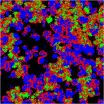(Press-News.org) Amsterdam, NL, April 7, 2014 – Two studies published in the Journal of Alzheimer's Disease indicate that some of the pathologic changes associated with Alzheimer's disease in older individuals are not apparent in young people who carry the apolipoprotein (APOE) genetic risk factor for developing the disease. In the first study, no differences were found in hippocampal volume or asymmetry between cognitively normal adolescent carriers and non-carriers of the ApoE ɛ4 or ɛ2 allelles. The second study reports no differences in plasma concentrations of amyloid-β peptides among young adult ɛ4, ɛ3 or ɛ2 carriers.
Carriers of the apolipoprotein (ApoE) ɛ4 allele are at greater risk for developing late-onset Alzheimer's disease (AD), develop AD at an earlier age, and experience a more severe cognitive decline and shorter survival times. The ɛ4 allele has also been linked to the severity of hippocampal atrophy and pathological alterations in the neocortex. The ɛ2 allele is thought to exert protection against the disease.
"Atrophy of the hippocampus, a region of the brain crucial for memory, is a common feature of AD, although it may also be detected in asymptomatic individuals as well as healthy adult carriers of the ApoE ɛ4 allele," explained Andy Simmons, PhD, of the Department of Neuroimaging of the Institute of Psychiatry of King's College London. "Whether young people genetically at risk for AD manifest early changes is an important question for those interested in interventions or treatments designed to slow or stop the progression of the disease."
To address the question, 1412 adolescents underwent MRI imaging and had blood samples tested for DNA analysis in order to determine their ApoE status. "Contrary to some recent studies, no hippocampal volume differences were observed between carriers and non-carriers of the ApoE ɛ4 allelle," said Dr. Simmons. The investigators also looked for other potential changes, such as hippocampal asymmetry or gene dose-dependent effects on volume, but could find no associations with genetic status.
In addition to structural changes in the brain, patients with AD typically show an increase in the brain load of amyloid-β (Aβ) peptides and a decrease in cerebrospinal fluid (CSF) concentration of Aβ peptides. Similar changes are found in almost all persons with mild cognitive impairment at risk of conversion to AD. "These changes represent the earliest diagnostic tools in AD," explains Professor Dr. med. Piotr Lewczuk, head of the Lab for Clinical Neurochemistry and Neurochemical Dementia Diagnostics, at the Department of Psychiatry and Psychotherapy, Universitätsklinikum Erlangen and Friedrich-Alexander-Universität Erlangen-Nürnberg. Since to some extent alterations of the concentrations of Aβ peptides are also observed in the blood, his research group explored differences in plasma levels of Aβ peptides among young adult ε4, ε3 or ε2 carriers.
To see whether these changes associated with AD are present at an early age, before clinical symptoms are apparent, investigators measured Aβ peptide concentrations in the plasma of 175 cognitively normal young adults. 40 individuals (22.9%) had at least one ε4 allele and were considered "at risk" for AD, 111 (63.4%) had the ε3/ε3 genotype and were considered "neutral," and 24 (13.7%) in the "protective: group had at least one ε2 allele.
The investigators measured four Aβ peptides and found that no significant differences in plasma levels of any of the Aβ peptides were found among the three genetic groups.
"The lack of differences of the Aβ concentrations reported in this study between the groups with and without increased genetic risk of AD does not mean that ongoing pre-clinical neurodegeneration can be fully excluded in all young subjects," says Dr. Lewczuk. He also notes that around 40% of AD patients are not carriers of the ε4 allele. However, he believes that both Dr. Simmons' findings concerning hippocampal volume and his study on plasma Aβ concentrations suggest that the AD-suggestive alterations begin perhaps 20-30 years before the onset of clinical symptoms, but most probably not earlier.
INFORMATION: END
No evidence of AD-associated changes in adolescents carrying genetic risk factors
According to 2 new studies published in the Journal of Alzheimer's Disease
2014-04-07
ELSE PRESS RELEASES FROM THIS DATE:
Parental obesity and autism risk in the child
2014-04-07
Several studies have looked at possible links between maternal obesity during pregnancy and the risk of developmental disorders in the child. However, paternal obesity could be a greater risk factor than maternal obesity, according to a new study from the Norwegian Institute of Public Health.
As the first researcher to study the role of paternal obesity in autism, Dr. Pål Surén emphasises that this is still a theory and requires much more research before scientists can discuss possible causal relationships.
"We have a long way to go. We must study genetic factors ...
Fatty acid composition in blood reflects the quality of dietary carbohydrates in children
2014-04-07
Recently published research in the University of Eastern Finland found that fatty acid composition in blood is not only a biomarker for the quality of dietary fat but also reflects the quality of dietary carbohydrates. For example the proportion of oleic acid was higher among children who consumed a lot of candy and little high-fibre grain products. Earlier studies on the topic have mainly concentrated on the association of the quality of dietary fat with fatty acid composition in blood. In the present study, the association of the quality of dietary carbohydrates with ...
Why do we get allergies? The science of springtime sniffling and sneezing (video)
2014-04-07
WASHINGTON, April 7, 2014 — Spring has sprung, and with it comes blooming flowers, shorts and t-shirts and, for the millions who suffer from allergies, a runny nose, puffy eyes and general misery. In the American Chemical Society's (ACS') latest Reactions video, we explain the science behind the allergies that spoil spring for so many people. The video is available at http://youtu.be/vFZlxQU0Pyk.
INFORMATION:
Subscribe to the series at Reactions YouTube, and follow us on Twitter @ACSreactions to be the first to see our latest videos.
The American Chemical Society ...
Health benefits of 'green exercise' for kids shown in new study
2014-04-07
Children who are exposed to scenes of nature while exercising are more likely to experience health-enhancing effects after activity, according to a Coventry University study published this week in the International Journal of Environmental Research and Public Health.
Sports science academics in the University's Department of Applied Sciences and Health asked kids aged 9-10 years to complete a series of 15 minute moderate intensity cycling activities – one whilst viewing a video of a forest track synced to the exercise bike and another with no visual stimulus.
The researchers ...
Energizing sick mitochondria with vitamin B3
2014-04-07
Vitamins B have recently been turned out to be potent modifiers of energy metabolism, especially the function of mitochondria.
Vitamin B3, (niacin) has been found to delay the signs of aging in animal models.
An international collaboration between the University of Helsinki and École Polytechnique Fédérale de Lausanne reported today in the high-profile journal, Embo Molecular Medicine, that vitamin B3 form, nicotinamide riboside, can slow down the progression of mitochondrial disease, suggesting its potential as a novel therapy approach to adult-onset mitochondrial ...
Organic solar cells more efficient with molecules face-to-face
2014-04-07
New research from North Carolina State University and UNC-Chapel Hill reveals that energy is transferred more efficiently inside of complex, three-dimensional organic solar cells when the donor molecules align face-on, rather than edge-on, relative to the acceptor. This finding may aid in the design and manufacture of more efficient and economically viable organic solar cell technology.
Organic solar cell efficiency depends upon the ease with which an exciton – the energy particle created when light is absorbed by the material – can find the interface between the donor ...
Switching off anxiety with light
2014-04-07
Receptors for the messenger molecule serotonin can be modified in such a way that they can be activated by light. Together with colleagues, neuroscientists from the Ruhr-Universität Bochum (RUB) report on this finding in the journal "Neuron". An imbalance in serotonin levels seems to cause anxiety and depression. The researchers have provided a new model system for investigating the mechanism underlying these dysfunctions in cell cultures as well as living organisms.
G protein coupled receptors play an important role in medicine and health
One receptor, which is important ...
The tiniest greenhouse gas emitters
2014-04-07
Climate feedbacks from decomposition by soil microbes are one of the biggest uncertainties facing climate modelers. A new study from the International Institute for Applied Systems Analysis (IIASA) and the University of Vienna shows that these feedbacks may be less dire than previously thought.
The dynamics among soil microbes allow them to work more efficiently and flexibly as they break down organic matter – spewing less carbon dioxide into the atmosphere than previously thought, according to a new study published in the journal Ecology Letters.
"Previous climate ...
Exploring the genetics of 'I'll do it tomorrow'
2014-04-07
Procrastination and impulsivity are genetically linked, suggesting that the two traits stem from similar evolutionary origins, according to research published in Psychological Science, a journal of the Association for Psychological Science. The research indicates that the traits are related to our ability to successfully pursue and juggle goals.
"Everyone procrastinates at least sometimes, but we wanted to explore why some people procrastinate more than others and why procrastinators seem more likely to make rash actions and act without thinking," explains psychological ...
Green tea boosts your brain
2014-04-07
Green tea is said to have many putative positive effects on health. Now, researchers at the University of Basel are reporting first evidence that green tea extract enhances the cognitive functions, in particular the working memory. The Swiss findings suggest promising clinical implications for the treatment of cognitive impairments in psychiatric disorders such as dementia. The academic journal Psychopharmacology has published their results.
In the past the main ingredients of green tea have been thoroughly studied in cancer research. Recently, scientists have also been ...
LAST 30 PRESS RELEASES:
Pew funds 7 new biomedical research collaborations
The ERC selects 349 mid-career researchers for €728 million in Consolidator Grants
ERC Consolidator Grant awarded to CISPA researcher Rayna Dimitrova
Antimicrobial effects of Syzygium aromaticum and Salvadora persica against common peri-implantitis pathogens in vitro
EVs pose no greater risk to pedestrians than conventional vehicles
Modeling microplastic accumulation under the ocean surface
Pompeii offers insights into ancient Roman building technology
University of Utah engineers give a bionic hand a mind of its own
Transient and long-term risks of common physical activities in people with low back pain
Health care contact days in older adults with metastatic cancer
Brain resilience science reshapes psychiatry from treating illness to building strength
An assessment of the antidepressant potential of deramciclane in two animal tests
Pitt and UPMC study finds epigenetic signature of pediatric traumatic brain injury, paves way for precision recovery tools
Brain discovery opens door to earlier detection of metabolic syndrome in women
SwRI-led study provides insight into oscillations in solar flares
Announcing the third cohort of the Hevolution/AFAR new investigator awards in aging biology and geroscience research
GeoFlame VISION: Using AI and satellite imagery to predict future wildfire risk
Nationwide study suggests that water treatment methods may impact the risk of legionnaires’ disease
Oyster larvae on drugs move slowly and are stressed
Targeting a specific brain circuit may help prevent opioid relapse, WSU study finds
Tec-Dara combination offers substantial improvement over standard second-line therapies for relapsed or refractory multiple myeloma
Improving treatment for an autoimmune bleeding condition
Drug reduced need for blood transfusions during hospitalization for non-cardiac surgery
Novel agent ianalumab added to standard therapy extends time to treatment failure in patients with previously treated immune thrombocytopenia
Pirtobrutinib outperforms bendamustine plus rituximab for previously untreated CLL/SLL
Online tracking and privacy on hospital websites
A freely available tool to document wartime destruction
Residential solar panels can raise electricity rates
Scientists use synthetic platelets as ‘Trojan horse’ drug-delivery system
Cooperative Intermolecular Interactions Regulate Supramolecular Polymer Assembly
[Press-News.org] No evidence of AD-associated changes in adolescents carrying genetic risk factorsAccording to 2 new studies published in the Journal of Alzheimer's Disease



